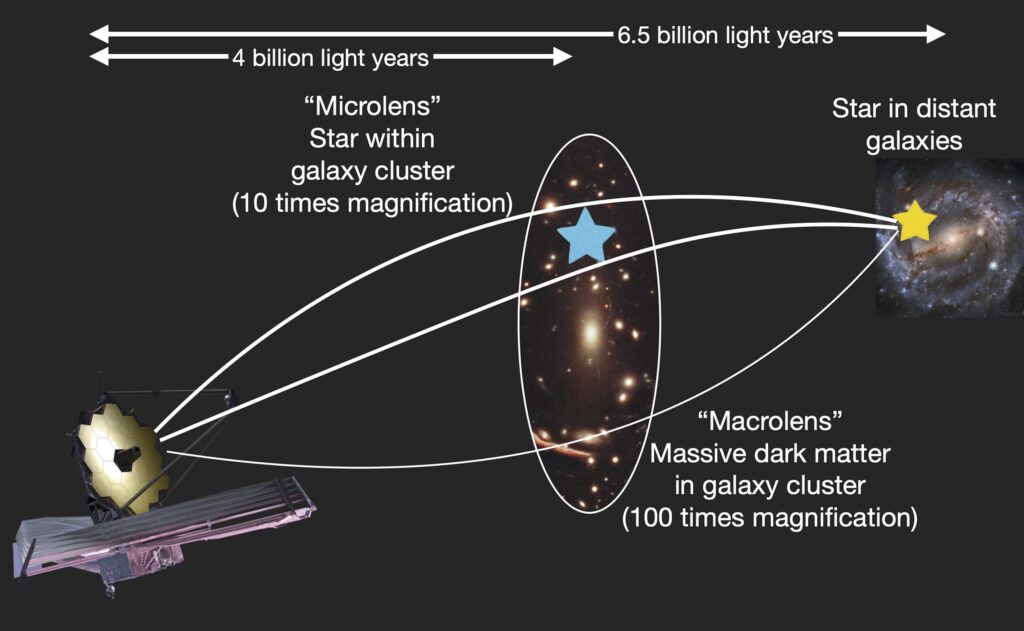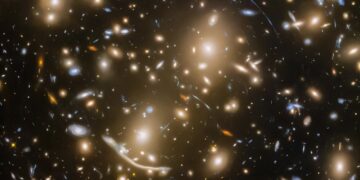Astronomy has taken a giant leap forward with the groundbreaking discovery of 44 individual stars in a distant galaxy located nearly 6.5 billion light-years away. This feat, achieved using NASA’s James Webb Space Telescope (JWST), has opened new doors to understanding the universe.
Peering Into the Cosmos: The Dragon Arc Discovery
The discovery of 44 stars within the Dragon Arc galaxy is a monumental achievement. Previously thought impossible, observing individual stars in a galaxy so distant is akin to spotting grains of sand from miles away. This achievement was made possible by a cosmic phenomenon known as gravitational lensing and the unparalleled capabilities of JWST.
Located behind the Abell 370 galaxy cluster, the Dragon Arc appears as a stretched-out, luminous spiral due to the massive gravitational forces of the cluster. These forces act as a cosmic magnifying glass, amplifying the light from the stars within the Dragon Arc and making them visible to the JWST.
Gravitational Lensing: A Cosmic Magnifier
Gravitational lensing, first predicted by Albert Einstein, is a natural phenomenon where the gravitational field of a massive object bends and amplifies light from a background object. In this case, the Abell 370 cluster served as the “macrolens,” magnifying the light from the Dragon Arc galaxy.

What makes this discovery even more remarkable is the role of individual stars within the Abell 370 cluster acting as “microlenses.” These microlenses further enhanced the visibility of the Dragon Arc’s stars, enabling the identification of 44 distinct points of light.
A New Frontier: Observing Red Supergiants
Among the 44 stars identified, many were red supergiants—stars in the final stages of their lives. Red supergiants, like Betelgeuse in our own galaxy, are cooler and larger than their blue counterparts. Their discovery highlights the unique ability of JWST to observe cooler, dimmer stars that were previously beyond reach.
By analyzing the colors and brightness of these stars, researchers gained insights into their temperature and composition. The presence of red supergiants also suggests that the Dragon Arc galaxy hosts a diverse stellar population, providing a glimpse into the stellar life cycles in the distant universe.
The Role of JWST in Transforming Astronomy
The James Webb Space Telescope is revolutionizing our understanding of the cosmos. Its ability to collect light across infrared wavelengths allows it to peer through cosmic dust and reveal hidden details. In this case, JWST’s powerful capabilities enabled astronomers to detect stars billions of light-years away.
Compared to its predecessor, the Hubble Space Telescope, JWST offers a much higher resolution and sensitivity. This advancement has expanded the boundaries of what astronomers can observe, turning theoretical possibilities into reality.
Implications for Dark Matter Research
The discovery of these stars has profound implications for understanding dark matter. The gravitational lensing effects observed in the Dragon Arc are directly influenced by the dark matter halo surrounding the Abell 370 cluster.
Dark matter, an invisible substance that makes up most of the universe’s mass, plays a crucial role in shaping cosmic structures. By studying how light from the Dragon Arc stars is bent and magnified, scientists can map the distribution of dark matter in the cluster. This research could help answer longstanding questions about the nature and behavior of dark matter.
Unlocking the Secrets of the Early Universe
This discovery is more than just a technical feat—it’s a window into the past. The Dragon Arc galaxy is located at a distance that corresponds to a time when the universe was half its current age. By observing its stars, astronomers can study galaxy formation and stellar evolution during this critical period.
The presence of red supergiants, for instance, offers clues about the life cycles of stars in the early universe.
Conclusion: A New Era of Discovery
The observation of 44 individual stars in the Dragon Arc galaxy represents a monumental step forward in astronomy. It showcases the power of JWST, the wonders of gravitational lensing, and the potential to unlock the universe’s secrets.
Reference:



















